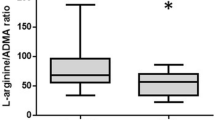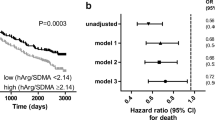Abstract
We hypothesise that asymmetric and symmetric dimethylarginine (ADMA, SDMA) are released in cerebrospinal fluid (CSF) due to ischemia-induced proteolysis and that CSF dimethylarginines are related to stroke severity. ADMA and SDMA were measured in CSF of 88 patients with ischemic stroke or TIA within 24 h after stroke onset (mean 8.6 h) and in 24 controls. Stroke severity was assessed by the National Institutes of Health Stroke Scale (NIHSS) score at admission. Outcome was evaluated by institutionalization due to stroke and the modified Rankin scale. Dimethylarginine levels were higher in patients with stroke than in TIA patients, who had higher levels than controls and correlated with the NIHSS. Logistic regression analysis confirmed that dimethylarginines were independently associated with stroke severity. The SDMA/ADMA ratio did not differ significantly between controls and stroke patients. CSF dimethylarginine levels are increased in hyperacute ischemic stroke and are associated with stroke severity.



Similar content being viewed by others
Abbreviations
- ADMA:
-
Asymmetric dimethylarginine
- CI:
-
Confidence interval
- CSF:
-
Cerebrospinal fluid
- CT:
-
Computed tomography
- Exp(β):
-
Exponential β
- MDRD:
-
Modification of diet in renal diseases formula
- mRS:
-
Modified Rankin scale
- MRI:
-
Magnetic resonance imaging
- NIHSS:
-
National Institutes of Health Stroke Scale
- SDMA:
-
Symmetric dimethylarginine
- TDMA:
-
Total dimethylarginine
- TIA:
-
Transient ischemic attack
References
Tran CT, Leiper JM, Vallance P (2003) The DDAH/ADMA/NOS pathway. Atheroscler Suppl 4:33–40. doi:10.1016/S1567-5688(03)00032-1
McBride AE, Silver PA (2001) State of the arg: protein methylation at arginine comes of age. Cell 106:5–8. doi:10.1016/S0092-8674(01)00423-8
Marescau B, Nagels G, Possemiers I et al (1997) Guanidino compounds in serum and urine of nondialyzed patients with chronic renal insufficiency. Metabolism 46:1024–1031. doi:10.1016/S0026-0495(97)90273-0
Martens-Lobenhoffer J, Sulyok E, Czeiter E et al (2007) Determination of cerebrospinal fluid concentrations of arginine and dimethylarginines in patients with subarachnoid haemorrhage. J Neurosci Methods 164:155–160. doi:10.1016/j.jneumeth.2007.04.005
Vallance P, Leone A, Calver A, Collier J, Moncada S (1992) Accumulation of an endogenous inhibitor of nitric oxide synthesis in chronic renal failure. Lancet 339:572–575. doi:10.1016/0140-6736(92)90865-Z
Selley ML (2003) Increased concentrations of homocysteine and asymmetric dimethylarginine and decreased concentrations of nitric oxide in the plasma of patients with Alzheimer’s disease. Neurobiol Aging 24:903–907. doi:10.1016/S0197-4580(03)00007-1
Arlt S, Schulze F, Eichenlaub M et al (2008) Asymmetrical dimethylarginine is increased in plasma and decreased in cerebrospinal fluid of patients with Alzheimer’s disease. Dement Geriatr Cogn Disord 26:58–64. doi:10.1159/000144026
Abe T, Tohgi H, Murata T, Isobe C, Sato C (2001) Reduction in asymmetrical dimethylarginine, an endogenous nitric oxide synthase inhibitor, in the cerebrospinal fluid during aging and in patients with Alzheimer’s disease. Neurosci Lett 312:177–179. doi:10.1016/S0304-3940(01)02214-5
Mulder C, Wahlund LO, Blomberg M et al (2002) Alzheimer’s disease is not associated with altered concentrations of the nitric oxide synthase inhibitor asymmetric dimethylarginine in cerebrospinal fluid. J Neural Transm 109:1203–1208. doi:10.1007/s00702-002-0760-1
Conte C, Floridi E, Galli F, Aisa C, Floridi A (2005) A new method for the liquid chromatography analysis of methylated arginines in biological fluids and tissues by o-phthaldialdehyde postcolumn derivatization. Anal Biochem 338:347–349. doi:10.1016/j.ab.2004.11.018
Jung CS, Oldfield EH, Harvey-White J et al (2007) Association of an endogenous inhibitor of nitric oxide synthase with cerebral vasospasm in patients with aneurysmal subarachnoid hemorrhage. J Neurosurg 107:945–950. doi:10.3171/JNS-07/11/0945
O’Kane RL, Vina JR, Simpson I, Zaragoza R, Mokashi A, Hawkins RA (2006) Cationic amino acid transport across the blood-brain barrier is mediated exclusively by system y+. Am J Physiol Endocrinol Metab 291:E412–E419. doi:10.1152/ajpendo.00007.2006
Go KG (1997) The normal and pathological physiology of brain water. Adv Tech Stand Neurosurg 23:47–142
Brouns R, Sheorajpanday R, Wauters A, De Surgeloose D, Marien P, De Deyn PP (2008) Evaluation of lactate as a marker of metabolic stress and cause of secondary damage in acute ischemic stroke or TIA. Clin Chim Acta 397:27–31. doi:10.1016/j.cca.2008.07.016
Brouns R, Heylen E, Sheorajpanday R et al (2009) Carboxypeptidase U (TAFIa) decreases the efficacy of thrombolytic therapy in ischemic stroke patients. Clin Neurol Neurosurg 111:165–170. doi:10.1016/j.clineuro.2008.09.002
Brouns R, Sheorajpanday R, Kunnen J, De Surgeloose D, De Deyn PP (2009) Clinical, biochemical and neuroimaging parameters after thrombolytic therapy predict long-term stroke outcome. Eur Neurol 774
Albers GW, Caplan LR, Easton JD et al (2002) Transient ischemic attack—proposal for a new definition. N Engl J Med 347:1713–1716. doi:10.1056/NEJMsb020987
Brott T, Adams HP Jr, Olinger CP et al (1989) Measurements of acute cerebral infarction: a clinical examination scale. Stroke 20:864–870
The European Stroke Organisation (ESO) Executive Committee and the ESO Writing Committee (2008) Guidelines for management of ischaemic stroke and transient ischaemic attack 2008. Cerebrovasc Dis 25:457–507. doi:10.1159/000131083
Adams HP Jr, Bendixen BH, Kappelle LJ et al (1993) Classification of subtype of acute ischemic stroke. Definitions for use in a multicenter clinical trial. TOAST. Trial of Org 10172 in acute stroke treatment. Stroke 24:35–41
Boger RH, Bode-Boger SM, Szuba A et al (1998) Asymmetric dimethylarginine (ADMA): a novel risk factor for endothelial dysfunction: its role in hypercholesterolemia. Circulation 98:1842–1847
Rawal N, Lee YJ, Paik WK, Kim S (1992) Studies on NG-methylarginine derivatives in myelin basic protein from developing and mutant mouse brain. Biochem J 287:929–935
Al Banchaabouchi M, Marescau B, Possemiers I, D’Hooge R, Levillain O, De Deyn PPNG (2000) NG-dimethylarginine and NG, NG-dimethylarginine in renal insufficiency. Pflugers Arch 439:524–531. doi:10.1007/s004240050973
Gobin YP, Starkman S, Duckwiler GR et al (2004) MERCI 1: a phase 1 study of mechanical embolus removal in cerebral ischemia. Stroke 35:2848–2854. doi:10.1161/01.STR.0000147718.12954.60
Sulter G, Steen C, De Keyser J (1999) Use of the Barthel index and modified Rankin scale in acute stroke trials. Stroke 30:1538–1541
Duncan PW, Jorgensen HS, Wade DT (2000) Outcome measures in acute stroke trials: a systematic review and some recommendations to improve practice. Stroke 31:1429–1438
Ogawa T, Kimoto M, Sasaoka K (1989) Purification and properties of a new enzyme, NG, NG-dimethylarginine dimethylaminohydrolase, from rat kidney. J Biol Chem 264:10205–10209
Kakimoto Y, Akazawa S (1970) Isolation and identification of N-G, N-G- and N-G, N’-G-dimethyl-arginine, N-epsilon-mono-, di-, and trimethyllysine, and glucosylgalactosyl- and galactosyl-delta-hydroxylysine from human urine. J Biol Chem 245:5751–5758
MacAllister RJ, Whitley GS, Vallance P (1994) Effects of guanidino and uremic compounds on nitric oxide pathways. Kidney Int 45:737–742. doi:10.1038/ki.1994.98
Cooke JP (2004) Asymmetrical dimethylarginine: the Uber marker? Circulation 109:1813–1818. doi:10.1161/01.CIR.0000126823.07732.D5
Calver A, Collier J, Vallance P (1993) Nitric oxide and the control of human vascular tone in health and disease. Eur J Med 2:48–53
Pacher P, Beckman JS, Liaudet L (2007) Nitric oxide and peroxynitrite in health and disease. Physiol Rev 87:315–424. doi:10.1152/physrev.00029.2006
Chan JR, Boger RH, Bode-Boger SM et al (2000) Asymmetric dimethylarginine increases mononuclear cell adhesiveness in hypercholesterolemic humans. Arterioscler Thromb Vasc Biol 20:1040–1046
Kielstein JT, Donnerstag F, Gasper S et al (2006) ADMA increases arterial stiffness and decreases cerebral blood flow in humans. Stroke 37:2024–2029. doi:10.1161/01.STR.0000231640.32543.11
Pullamsetti S, Kiss L, Ghofrani HA et al (2005) Increased levels and reduced catabolism of asymmetric and symmetric dimethylarginines in pulmonary hypertension. FASEB J 19:1175–1177
Sydow K, Munzel T (2003) ADMA and oxidative stress. Atheroscler Suppl 4:41–51. doi:10.1016/S1567-5688(03)00033-3
MacAllister RJ, Parry H, Kimoto M et al (1996) Regulation of nitric oxide synthesis by dimethylarginine dimethylaminohydrolase. Br J Pharmacol 119:1533–1540
Kazmierski R (2006) Predictors of early mortality in patients with ischemic stroke. Expert Rev Neurother 6:1349–1362. doi:10.1586/14737175.6.9.1349
Miyazaki H, Matsuoka H, Cooke JP et al (1999) Endogenous nitric oxide synthase inhibitor: a novel marker of atherosclerosis. Circulation 99:1141–1146
Khan U, Hassan A, Vallance P, Markus HS (2007) Asymmetric dimethylarginine in cerebral small vessel disease. Stroke 38:411–413. doi:10.1161/01.STR.0000254500.27412.ac
Wanby P, Teerlink T, Brudin L et al (2006) Asymmetric dimethylarginine (ADMA) as a risk marker for stroke and TIA in a Swedish population. Atherosclerosis 185:271–277. doi:10.1016/j.atherosclerosis.2005.06.033
Acknowledgments
R. B. is a research assistant of the Fund for Scientific research Flanders (FWO-Vlaanderen). This research was also supported by the Institute Born-Bunge; the agreement between the Institute Born-Bunge and the University of Antwerp; the Interuniversity Attraction Poles (IAP) program P6/43 of the Belgian Federal Science Policy Office, Belgium; and the Medical Research Foundation Antwerp.
Author information
Authors and Affiliations
Corresponding author
Additional information
R. Brouns is a research assistant of the Fund for Scientific research Flanders (FWO-Vlaanderen).
Rights and permissions
About this article
Cite this article
Brouns, R., Marescau, B., Possemiers, I. et al. Dimethylarginine Levels in Cerebrospinal Fluid of Hyperacute Ischemic Stroke Patients are Associated with Stroke Severity. Neurochem Res 34, 1642–1649 (2009). https://doi.org/10.1007/s11064-009-9954-3
Received:
Accepted:
Published:
Issue Date:
DOI: https://doi.org/10.1007/s11064-009-9954-3




